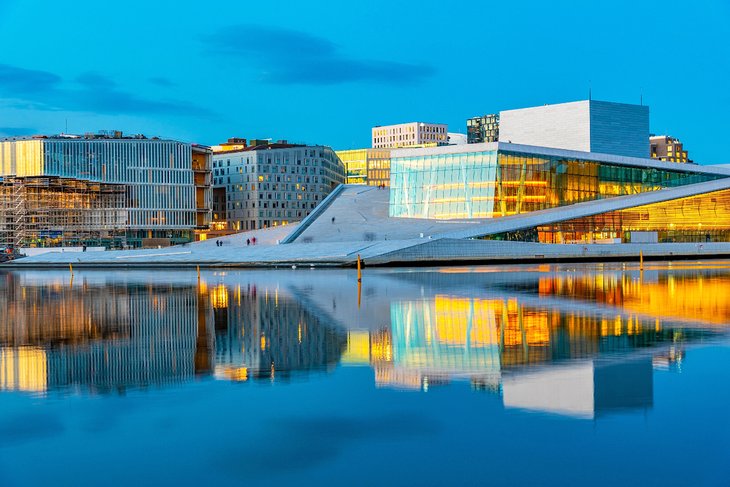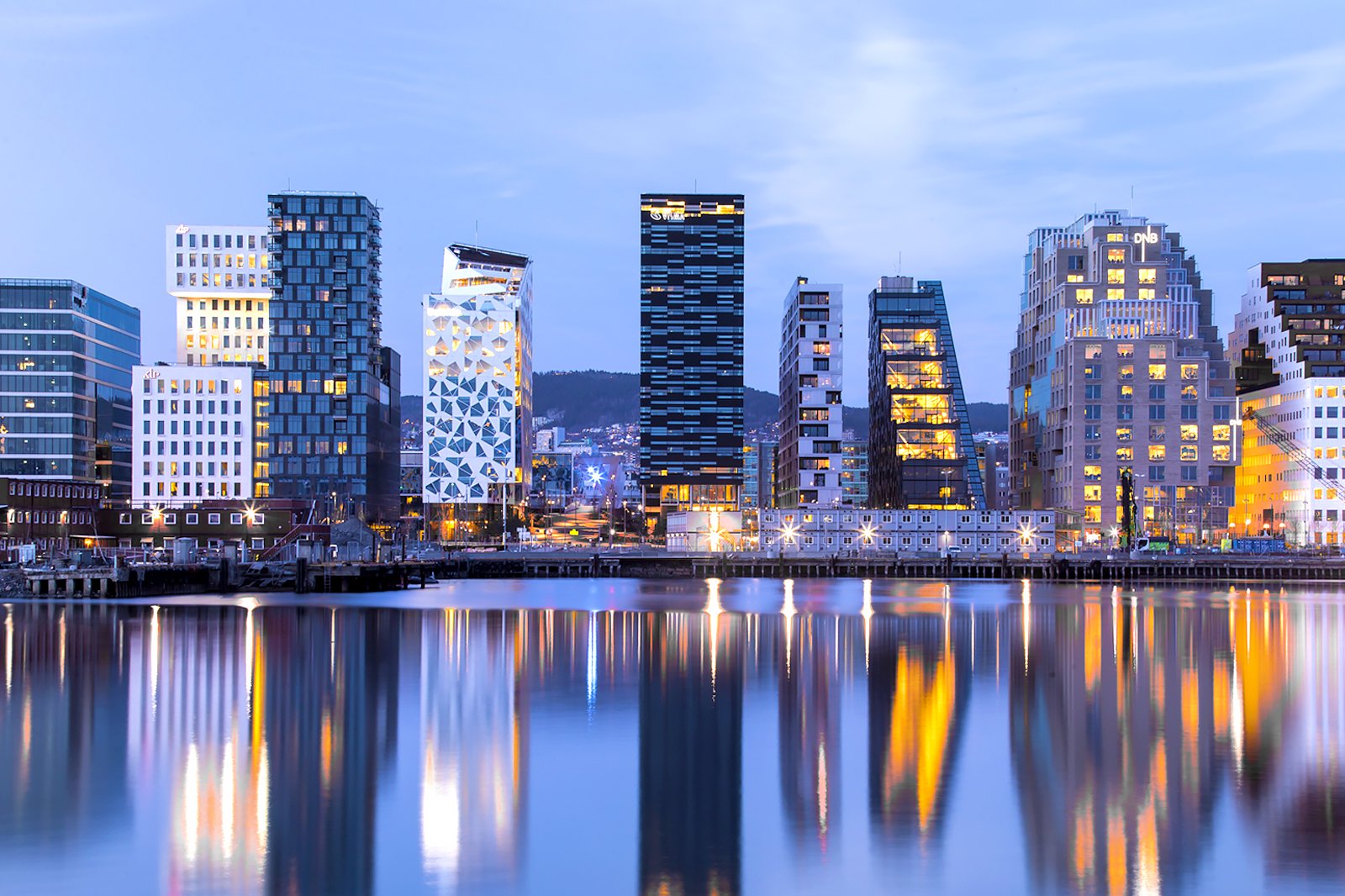
Oslo, Norway’s vibrant capital, is a city that effortlessly blends centuries of rich history with a breathtaking natural landscape and a thriving modern culture. Nestled at the northern tip of the Oslofjord, this compact and walkable city offers a captivating experience for every traveler, from history buffs and art enthusiasts to nature lovers and foodies. Prepare to be enchanted by its charming cobblestone streets, its world-class museums, its verdant parks, and its innovative spirit.
A Glimpse into Oslo’s Storied Past
Oslo’s history stretches back over a thousand years, with its origins dating back to the Viking Age. Founded in 1040 by King Harald Hardrada, the city quickly grew into a significant trading and religious center. Its strategic location on the fjord meant it was a hub for both commerce and defense. Over the centuries, Oslo has weathered fires, plagues, and periods of foreign rule, yet it has always risen from the ashes, demonstrating remarkable resilience and a strong sense of identity.
Related Articles about Oslo: A Symphony of History, Nature, and Modernity:
- Germany: A Journey Through Time, Culture, and Unforgettable Landscapes
- A Traveler’s Tapestry: Your Comprehensive Guide to Malaysia
- The Great American Adventure: Your Comprehensive Travel Guide to the USA
- Australia: A Land of Wonders – Your Ultimate Guide to Adventure
- Unveiling the Majesty: A Guide to the Best Tourist Attractions in the United Kingdom
During the medieval period, Oslo was the capital of Norway, and remnants of this era can still be found. The imposing Akershus Fortress, a medieval castle and royal residence, stands as a testament to its historical importance. The city also played a crucial role during the Hanseatic League’s influence in Scandinavia, fostering trade and cultural exchange.
In later centuries, Oslo, then known as Christiania, experienced periods of significant growth and development, particularly during the 19th century, as Norway began to assert its independence. The city became a focal point for Norwegian nationalism, art, and literature, with prominent figures like Henrik Ibsen calling it home. Today, Oslo proudly showcases its heritage through its museums, architecture, and preserved historical sites, offering visitors a tangible connection to its past.
Unveiling Oslo’s Main Attractions: A Journey of Discovery
Oslo boasts an impressive array of attractions that cater to diverse interests. From iconic landmarks to hidden gems, here’s a curated selection of must-visit spots:
1. The Viking Ship Museum (Vikingskipshuset): Step back in time and marvel at the remarkably preserved Viking ships, including the Oseberg, Gokstad, and Tune ships. These ancient vessels, unearthed from burial mounds, offer a profound glimpse into the seafaring prowess and rich mythology of the Vikings. The museum also showcases artifacts, tools, and personal belongings that further illuminate this fascinating era.
2. The Munch Museum (Munchmuseet): Dedicated to the life and works of Edvard Munch, Norway’s most celebrated artist, this museum is an essential pilgrimage for art lovers. Its vast collection includes iconic masterpieces like "The Scream," offering a powerful and evocative exploration of human emotion and the Norwegian psyche. The new, architecturally striking museum offers an immersive experience with its vast collection and innovative exhibitions.
3. Vigeland Sculpture Park (Vigelandsanlegget): This unique and expansive park is a testament to the visionary sculptor Gustav Vigeland. It features over 200 sculptures crafted from bronze, granite, and cast iron, depicting the cycle of human life from birth to death. The park’s centerpiece, the Monolith, a towering column of human figures, is a truly awe-inspiring sight. It’s a perfect place for a leisurely stroll and contemplation.
4. Akershus Fortress (Akershus Festning): Perched majestically overlooking the Oslofjord, this medieval fortress has stood guard over the city for over 700 years. Explore its ramparts, dungeons, and courtyards, and delve into its history as a royal residence, military stronghold, and even a prison. The fortress offers breathtaking panoramic views of the harbor and the city, making it a popular spot for both history enthusiasts and photographers.
5. The Royal Palace (Det Kongelige Slott): The official residence of the Norwegian monarch, the Royal Palace is an elegant Neoclassical building set amidst beautiful gardens. Witness the changing of the guard ceremony, a daily spectacle that adds a touch of regal charm to the city. While tours of the interior are limited, the exterior and surrounding grounds are worth exploring.
6. The Opera House (Operahuset): A modern architectural marvel, the Oslo Opera House appears to rise directly from the water, its white marble facade inviting visitors to walk on its roof. Designed to resemble an iceberg, it offers stunning views of the fjord and the city. Beyond its visual appeal, it’s a world-class venue for opera, ballet, and other performances.
7. Bygdøy Peninsula: This peninsula is a cultural treasure trove, home to several significant museums. In addition to the Viking Ship Museum, you’ll find the Norwegian Folk Museum (Norsk Folkemuseum), an open-air museum showcasing traditional Norwegian buildings and life from different regions and periods, and the Fram Museum, dedicated to Norwegian polar exploration.
8. Karl Johans Gate: Oslo’s main street, Karl Johans Gate, is a bustling artery connecting the Central Station to the Royal Palace. Lined with shops, restaurants, theaters, and historical buildings, it’s the perfect place to soak in the city’s atmosphere, people-watch, and do some souvenir shopping.
9. Holmenkollen Ski Jump: For sports enthusiasts and those seeking panoramic vistas, a visit to Holmenkollen is a must. This iconic ski jump offers breathtaking views of Oslo and the surrounding landscape. You can also visit the Ski Museum, the oldest of its kind in the world, to learn about the history of skiing.
10. Grünerløkka: This trendy and vibrant neighborhood is a hub for independent boutiques, vintage stores, cozy cafes, and lively bars. It’s the perfect place to experience Oslo’s contemporary culture, enjoy delicious food, and discover unique local finds.
Navigating Oslo: Essential Travel Tips
To make the most of your Oslo adventure, keep these practical tips in mind:
- Oslo Pass: Consider purchasing an Oslo Pass, which offers free admission to many museums and attractions, as well as unlimited travel on public transport. It’s an excellent way to save money and explore the city efficiently.
- Currency: The currency in Norway is the Norwegian Krone (NOK). Credit and debit cards are widely accepted, but it’s advisable to have some cash for smaller purchases.
- Language: The official language is Norwegian. However, English is widely spoken, especially in tourist areas, hotels, and restaurants.
- Tipping: Tipping is not customary in Norway, as service is generally included in the price. However, if you receive exceptional service, a small tip is appreciated.
- Weather: Oslo experiences distinct seasons. Pack layers as the weather can be unpredictable. Comfortable walking shoes are essential, as you’ll likely be doing a lot of exploring on foot.
- Book in Advance: For popular attractions and accommodations, especially during peak season, it’s advisable to book in advance to avoid disappointment.
The Best Time to Visit Oslo: Embracing the Seasons
Oslo offers a unique charm throughout the year, with each season providing a different experience:
- Spring (April-May): As the snow melts and nature awakens, Oslo bursts into bloom. The days become longer, and the city’s parks and outdoor spaces become inviting. This is a great time to explore without the peak summer crowds.
- Summer (June-August): Summer is Oslo’s peak tourist season, with long daylight hours and pleasant temperatures. It’s the ideal time for outdoor activities, exploring the fjords, and enjoying the city’s vibrant atmosphere. Expect more crowds and higher prices.
- Autumn (September-October): The autumn colors in Oslo are spectacular, with the city’s parks and forests ablaze with reds, oranges, and yellows. The air is crisp, and the city offers a more relaxed pace. It’s a wonderful time for hiking and enjoying the natural beauty.
- Winter (November-March): Oslo transforms into a winter wonderland, especially in December, with festive Christmas markets and a cozy atmosphere. While it can be cold, it’s also a magical time for experiencing winter sports, ice skating, and enjoying the warmth of local cafes. The Northern Lights are also a possibility in the surrounding regions during winter.
Cozy Havens: Nearby Hotels in Oslo
Oslo offers a wide range of accommodation options to suit every budget and preference. Here are some areas and types of hotels to consider:
- City Center (Sentrum): For proximity to major attractions, shopping, and transport links, the city center is an excellent choice. You’ll find everything from luxury hotels to comfortable mid-range options.
- Luxury: The Grand Hotel, Amerikalinjen
- Mid-Range: Thon Hotel Cecil, Clarion Collection Hotel Folketeateret
- Budget-Friendly: Smarthotel Oslo, Anker Hotel
- Aker Brygge & Tjuvholmen: These waterfront districts offer stylish hotels with stunning fjord views and easy access to restaurants and cultural attractions.
- Luxury: The Thief
- Mid-Range: Clarion Hotel The Hub
- Grünerløkka: If you prefer a more bohemian and local vibe, Grünerløkka offers boutique hotels and charming guesthouses.
- Boutique: Grünerløkka Apartments
- Bygdøy: For a more tranquil setting surrounded by nature, consider hotels on the Bygdøy peninsula, offering a peaceful retreat.
A Taste of Norway: Local Food to Savor
Norwegian cuisine is characterized by its fresh ingredients, particularly seafood and game. Don’t leave Oslo without trying these local delicacies:
- Fårikål: Often considered Norway’s national dish, this hearty stew of lamb and cabbage is a must-try, especially during autumn.
- Lutefisk: A traditional dish of dried whitefish treated with lye, it has a unique texture and flavor that is an acquired taste but deeply ingrained in Norwegian culinary history.
- Rakfisk: Fermented fish, usually trout, which is pungent and often served with flatbread and sour cream.
- Salmon: Norway is renowned for its world-class salmon. Enjoy it smoked, grilled, or cured in various delicious preparations.
- Reindeer and Elk: These game meats are popular in Norwegian cuisine and are often served in stews or as roasted dishes.
- Brunost (Brown Cheese): A sweet, caramel-like cheese that is a staple in Norwegian households, often enjoyed on bread or waffles.
- Skillingsboller: Sweet cinnamon buns, perfect for a coffee break.
- Waffles (Vafler): Typically served with jam and sour cream, Norwegian waffles are a delightful treat.
Oslo also boasts a thriving culinary scene with international influences, so you’ll find a wide variety of restaurants offering global flavors.
Seamless Exploration: Transportation Options in Oslo
Oslo is a remarkably easy city to navigate, thanks to its efficient and integrated public transportation system.
- Public Transport (Ruter): The Ruter network encompasses buses, trams, metro (T-bane), and ferries, all operating on a unified ticketing system. You can purchase single tickets, day passes, or use the Ruter app for easy access. The metro system is particularly efficient for reaching different parts of the city and its surrounding areas.
- Walking: Oslo is a very walkable city, especially its central areas. Many attractions are within easy reach of each other, allowing you to discover hidden gems at your own pace.
- Cycling: Oslo is increasingly bicycle-friendly, with dedicated bike lanes and bike-sharing schemes available. It’s a fantastic way to explore the city and its parks, especially during the warmer months.
- Taxis: Taxis are readily available, but they can be more expensive than public transport. Look for official taxi stands or use reputable taxi apps.
- Ferries: Ferries are an essential part of Oslo’s transportation network, connecting the city center to the islands of the Oslofjord, as well as the Bygdøy peninsula.
In conclusion, Oslo is a city that captivates with its harmonious blend of historical depth, natural splendor, and contemporary dynamism. From the echoes of Viking sagas within its museums to the panoramic vistas from its modern architectural marvels, Oslo offers an unforgettable journey. With its welcoming atmosphere, efficient transportation, and a culinary scene that tantalizes the taste buds, this Nordic gem is ready to be explored, promising an experience that will linger long after you depart.








